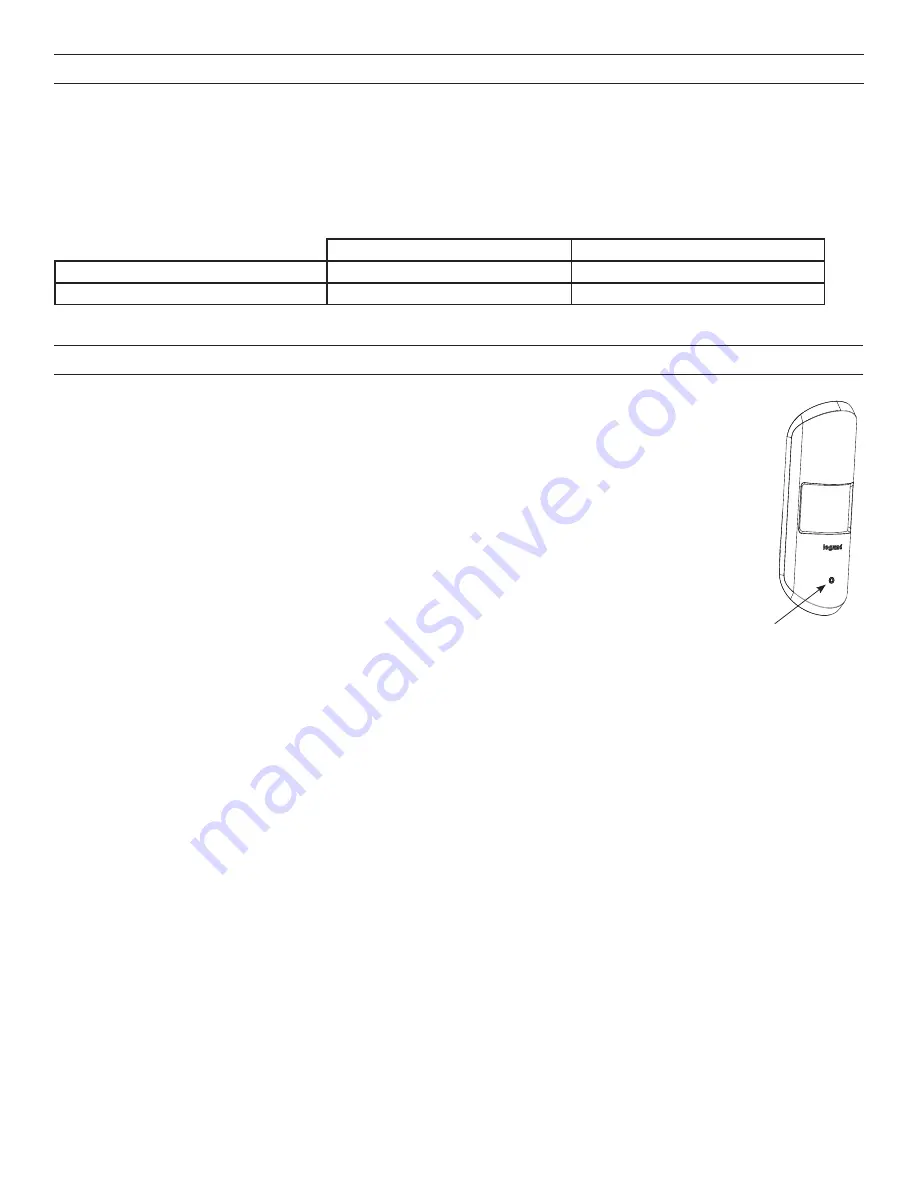
4
DEVICE PAIRING USING PUSH-TO-PAIR MODE
Push-to-Pair in a room with a single LMRC-611 Room Controller
NOTE:
Once you enter PtP mode on the room controller, a three minute timer begins. If the Config button on any
device in the room is pressed, the timer resets and begins the three minute countdown again. If no Config
button is pressed within three minutes, the room controller will exit PtP mode.
1.
Enter PtP mode
on the room controller.
Press the Config button three times (within three seconds) until the
LED on the room controller flashes green.
2.
Enter PtP mode on the LMPX-600.
Press the Config button three times. As with the room controller, the LED on
the sensor will flash green.
3.
Pair the LMPX-600.
Press the Config button on the LMPX-600 once to pair it to the room controller. The load
connected to the room controller will toggle once (if the load is OFF, it will turn ON; if ON, it will turn OFF) to
indicate that pairing was successful. Also, the LMPX-600’s blinking LED will turn to solid green as another
indicator of a successful pairing.
NOTE: If there are any wireless sensors, dimmers, or additional switches in the room, repeat steps 2 and
3
for each of those devices so that all devices are paired together in the same network. For each device,
the load will toggle during step 3 and its config LED will turn solid green.
4.
Exit PtP mode.
Exit PtP on the room controller, by pressing the Config button 3 times. The LED on the room
controller will flash blue while it completes the pairing process. The default Network ID on all devices will change to a new number,
based on the last four digits of the Mac address on the room controller, and now those devices will communicate only with each
other and not any devices which have not been paired. Once complete, the switches and sensors will automatically exit PtP mode
and will reboot. The LED on each switch or sensor will flash white at least once before resuming normal operation.
NOTE:
It is important to exit PtP mode within the three minute time limit mentioned above. If you do not, none of the device
pairings will be remembered and you have to start the process over from the beginning.
Push-to-Pair in a room with multiple LMRC-611s
In a room with multiple loads, there may be more than one LMRC-611. They can all be paired to the same room network, allowing the
scene switch to set each load to different levels per scene. One of the room controllers will become the master, determining the Network
ID and channel settings for all the devices in the network.
1.
Enter wireless Push-to-Pair (PtP) mode
on all room controllers.
Press the Config button three times on each LMRC-611 to put
them all in PtP mode. The green LEDs will flash on all room controllers. The first room controller placed into PtP will become the
master.
2.
Pair the room controllers together.
Press the Config button once on each room controller. This indicates to the rooms controllers
that they will be paired with each other.
The master room controller’s LED blink rate will double once the first device is paired to it. This faster blink rate is convenient when
multiple room controllers are present on the same network.
3.
Enter PtP mode on the LMPX-600.
Press the Config button three times. As with the room controller, the LED on the sensor will
flash green.
4.
Pair the LMPX-600.
Press the Config button on the LMPX-600 once to pair it to the room controllers. The loads connected to the
room controllers will toggle once (if the load is OFF, it will turn ON; if ON, it will turn OFF) to indicate that pairing was successful.
NOTE: If there are any wireless sensors, dimmers, or additional switches in the room, repeat steps 3 and 4
for each of those
devices so that all devices are paired together in the same network. For each device, the load will toggle during step 4.
5.
Exit PtP mode.
From any device, press the Config button 3 times. The LED on the room controller will flash blue while it
completes the pairing process. The default Network ID on all devices will change to a new number, based on the last four digits of
the Mac address on the room controller, and now those devices will communicate only with each other and not any devices which
have not been paired. Once complete, the switches and sensors will automatically exit PtP mode. The LED on each switch or
sensor will flash white at least once before resuming normal operation.
Config Button
SETTING UP A ROOM NETWORK BY PAIRING DEVICES
Pair wireless devices to a room controller to create a secure individual room network and enable Plug N’ Go operation.
Device pairing can be done by using Push-to-Pair (PtP) mode on the room controller and all other wireless devices, or by using the
DLM Config App.
To pair devices in a network, they must all have the same wireless channel and Network ID. By default the channel is 15 and the
Network ID is 1. Using Push-to-Pair mode, the Network ID for all devices being paired is migrated to a new number, so that only those
device communicate with each other. Note that while the channel remains at its default value using Push-to-Pair, if you pair devices
using the DLM Config app, you can also change the channel.
Recommended Pairing Methods for Different Scenarios
Rooms with One Room Controller
Rooms with Multiple Room Controllers
Set Up a new room network
DLM Config App or Push-to-Pair Mode DLM Config App or Push-to-Pair Mode
Add a device to an existing room network
DLM Config App or Push-to-Pair Mode DLM Config App
NOTE:
LMCS-100 software, version 4.7 or later can also be used to pair devices. However, LMCS-100 requires use of an LMBR-650.






